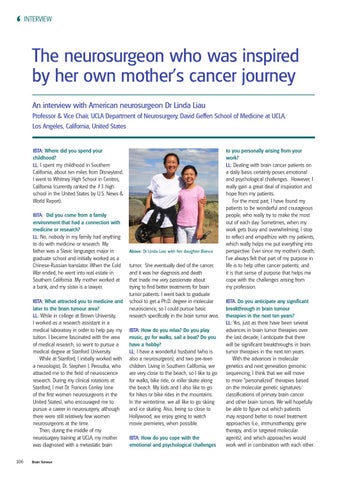‘
INTERVIEW
The neurosurgeon who was inspired by her own mother’s cancer journey An interview with American neurosurgeon Dr Linda Liau Professor & Vice Chair, UCLA Department of Neurosurgery, David Geffen School of Medicine at UCLA, Los Angeles, California, United States IBTA: Where did you spend your childhood? LL: I spent my childhood in Southern California, about ten miles from Disneyland. I went to Whitney High School in Cerritos, California (currently ranked the #3 high school in the United States by U.S. News & World Report). IBTA: Did you come from a family environment that had a connection with medicine or research? LL: No, nobody in my family had anything to do with medicine or research. My father was a Slavic languages major in graduate school and initially worked as a Chinese-Russian translator. When the Cold War ended, he went into real estate in Southern California. My mother worked at a bank, and my sister is a lawyer. IBTA: What attracted you to medicine and later to the brain tumour area? LL: While in college at Brown University, I worked as a research assistant in a medical laboratory in order to help pay my tuition. I became fascinated with the area of medical research, so went to pursue a medical degree at Stanford University. While at Stanford, I initially worked with a neurologist, Dr. Stephen J. Peroutka, who attracted me to the field of neuroscience research. During my clinical rotations at Stanford, I met Dr. Frances Conley (one of the first women neurosurgeons in the United States), who encouraged me to pursue a career in neurosurgery, although there were still relatively few women neurosurgeons at the time. Then, during the middle of my neurosurgery training at UCLA, my mother was diagnosed with a metastatic brain 106
Brain Tumour
Above: Dr Linda Liau with her daughter Bianca
tumor. She eventually died of the cancer, and it was her diagnosis and death that made me very passionate about trying to find better treatments for brain tumor patients. I went back to graduate school to get a Ph.D. degree in molecular neuroscience, so I could pursue basic research specifically in the brain tumor area. IBTA: How do you relax? Do you play music, go for walks, sail a boat? Do you have a hobby? LL: I have a wonderful husband (who is also a neurosurgeon), and two pre-teen children. Living in Southern California, we are very close to the beach, so I like to go for walks, bike ride, or roller skate along the beach. My kids and I also like to go for hikes or bike rides in the mountains. In the wintertime, we all like to go skiing and ice skating. Also, being so close to Hollywood, we enjoy going to watch movie premieres, when possible. IBTA: How do you cope with the emotional and psychological challenges
to you personally arising from your work? LL: Dealing with brain cancer patients on a daily basis certainly poses emotional and psychological challenges. However, I really gain a great deal of inspiration and hope from my patients. For the most part, I have found my patients to be wonderful and courageous people, who really try to make the most out of each day. Sometimes, when my work gets busy and overwhelming, I stop to reflect and empathize with my patients, which really helps me put everything into perspective. Ever since my mother’s death, I’ve always felt that part of my purpose in life is to help other cancer patients; and it is that sense of purpose that helps me cope with the challenges arising from my profession. IBTA: Do you anticipate any significant breakthrough in brain tumour therapies in the next ten years? LL: Yes, just as there have been several advances in brain tumor therapies over the last decade, I anticipate that there will be significant breakthroughs in brain tumor therapies in the next ten years. With the advances in molecular genetics and next generation genomic sequencing, I think that we will move to more “personalized” therapies based on the molecular genetic signatures/ classifications of primary brain cancer and other brain tumors. We will hopefully be able to figure out which patients may respond better to novel treatment approaches (i.e., immunotherapy, gene therapy, and/or targeted molecular agents), and which approaches would work well in combination with each other.
